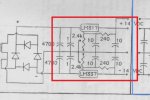lazer
0
- Joined
- Dec 21, 2008
- Messages
- 361
- Points
- 0
I'm trying to build the circuit attached. I'm having a little bit of trouble with the amp side (red outlined section) though and finding the correct ICs. I looked on Digikey and Mouser but am not sure which to get. The diagram says that I need the TL062. However when I search for that I get a list of several different choices. How do I know which one to use? Also could someone explain what the 1/2 next to the TL062 means? I haven't come across that before as I normally don't use op amps.
This is what you get on Digi-Key by just searching through hole TL062:


Here's the entire circuit:

This is what you get on Digi-Key by just searching through hole TL062:


Here's the entire circuit:

Last edited:






